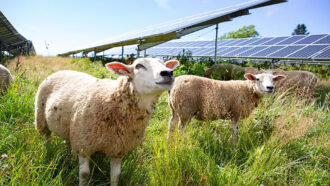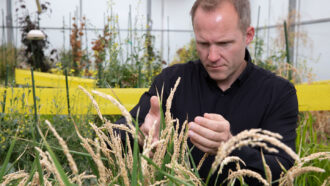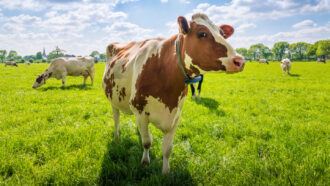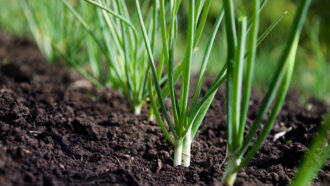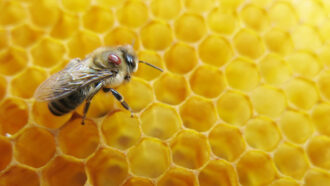Building better, safer soils
Geology and chemistry pave the way for safer city farming
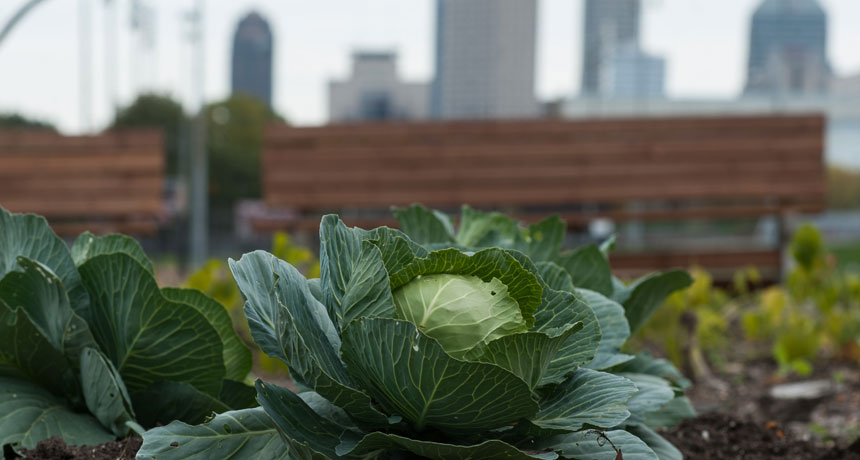
Urban gardening offers more access to fresh produce in the city. The problem: Some city soils can have dangerously high lead levels.
Howellboy, Wikimedia Commons
BALTIMORE, Md. — Urban farming can help families in inner cities enjoy more fresh fruits and vegetables. Community gardens also help people get exercise and bring neighbors together. But there’s one big problem. Soils in many cities have high levels of lead. That toxic heavy metal harms the brain and nervous system, leading to health problems, especially in children. But scientists have just announced some success in building safer soils.
Yes, building them.
Sara Perl Egendorf is a soils scientist with Brooklyn College of the City University of New York and the New York City (NYC) Urban Soils Institute. She and her team worked with the Mayor’s office and city parks department to fix some local soils.
They started by collecting sediment dug up from building sites. Glaciers left this sediment throughout the area at the end of the last ice age. It was much like what happens when dirty snow banks melt — only much larger. Plants can grow in glacial sediments. But it’s hard for plants to get needed nutrients from it, such as nitrogen and phosphorus. So Egendorf’s team added compost. That’s mainly decayed plant materials, rich in nutrients. It came from the Gowanus Canal Conservancy in Brooklyn, N.Y.
Both the compost and the sediment from building sites “are materials that would otherwise be entering the waste stream,” says Egendorf. “So, we diverted them from landfills.” They’re now providing a service as soil.
The team tested different combinations of sediment and compost. One mixture had an equal, 50-50 mix. Another added one part compost to two parts of sediment. Another mix used one part compost to four parts sediment.
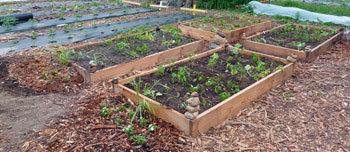
In the first year, the 50-50 mix produced more crops than did the store-bought topsoil. Scientists are still working to test the crops for lead and other metals. However, the earliest lab results for that first harvest suggest the produce is safe to eat.
Testing the crops is “a real strength of Egendorf’s work,” notes Dan Brabander. As a geoscientist at Wellesley College in Massachusetts, he deals with geology, chemistry, health and the environment.
Brabander also likes the fact that the New York City group ran controlled tests. By growing crops side-by-side under the same conditions, the researchers could largely rule out that anything other than the soil type affected the results.
Making soil safer
Brabander and his colleagues also study ways to reduce risks from lead in urban gardens. One of his projects has looked at how compost can help community gardens near Boston, Mass.
High school students had worked with The Food Project of Lincoln, Mass., to build raised garden beds. At first, gardeners filled the beds with compost. Over several years, though, neighborhood soils settled or got mixed into the beds.
The Massachusetts group examined the fine particles in the beds’ soils. These are the bits of dirt that “people are more likely to come in contact with,” explains Rosalie Sharp of Wellsley College. They can get flung into the air. Those bits also can stick to hands.
Tests showed that these very fine particles probably came from the neighborhood soil. And they had 10 times more lead in them than similar-size particles that came mainly from compost!
The team also tested for different forms of lead in the soil. Some types are less likely to be taken up by crops and would be less harmful if eaten as part of a plant.
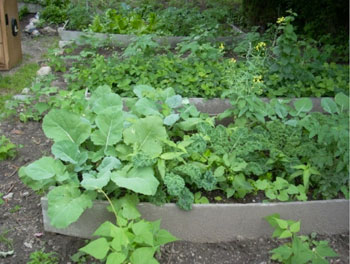
The chemistry of the soil itself probably also matters, Sharp and Brabander say. For example, higher levels of compounds with carbon might make the lead less dangerous. Other factors might also play a role. More acidic soil can leach lead from soil, for example.
Egendorf likes the fact that the Massachusetts group tested fine particles both from the compost and the local soils. “Documenting the differences between these materials is essential,” she says. She also likes the way the group has been probing the effects of different forms of lead. The work helps show how the chemical make-up of compost can make soil safer.
Testing for lead
Other work by the Massachusetts team uses portable equipment for rapid, on-the-spot soil sampling. In one round of tests, the group found that lead levels in most spots were under 400 parts per million (ppm). The U.S. Environmental Protection Agency considers that an acceptable amount.
Some soil “hot spots,” however, had lead levels of up to 700 ppm. “So testing in one spot in a garden doesn’t necessarily give you a [good gauge] for the whole garden,” Sharp says. Eventually, portable testing results could pinpoint where extra compost or other treatments might be needed to cut lead risks. Testing could also guide choices on where to plant crops that are most likely to take up metals into their edible parts.
The groups shared their findings here at the annual meeting of the Geological Society of America on November 2 and 4. Both groups also will continue their research. For now, though, building soil and adding compost to existing soil both seem like promising ideas. At some point, the approaches might even work together, the scientists say.
“What I think is really exciting from Sara’s work and our work is utilizing materials that already exist within the city,” Brabander says. Such recycling could help inner-city families enjoy safer, healthier food.
Power Words
(for more about Power Words, click here)
compost The end product in the breakdown, or decomposition, of leaves, plants, vegetables, manure and other once-living material. Compost is used to enrich garden soil, and earthworms sometimes aid this process.
decomposition The process by which compounds in once-living things are broken down and returned to the environment; the process by which something decays or rots.
geology The study of Earth’s physical structure and substance, its history and the processes that act on it. People who work in this field are known as geologists. Planetary geology is the science of studying the same things about other planets.
geoscience Any of a number of sciences, like geology or atmospheric science, concerned with better understanding the planet. People who work in this field are known as geoscientists.
glacier A slow-moving river of ice hundreds or thousands of meters deep. Glaciers are found in mountain valleys and also form parts of ice sheets.
leach (in geology and chemistry) The process by which water (often in the form of rain) removes soluble minerals or other chemicals from a solid, such as rock, sand, soil or ash.
lead A toxic heavy metal (abbreviated as Pb) that in the body moves to where calcium wants to go. The metal is particularly toxic to the brain, where in a child’s developing brain it can permanently impair IQ (a test score that aims to measure intelligence)even at relatively low levels.
nutrients Vitamins, minerals, fats, carbohydrates and proteins needed by organisms to live, and which are extracted through the diet.
organic (in chemistry) An adjective that indicates something is carbon-containing; a term that relates to the chemicals that make up living organisms. (in agriculture) Farm products grown without the use of non-natural and potentially toxic chemicals, such as pesticides.
particle A minute amount of something.
sediment Material (such as stones and sand) deposited by water, wind or glaciers.


